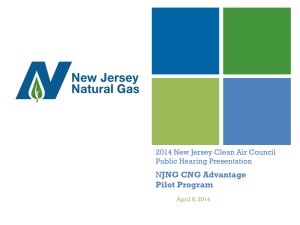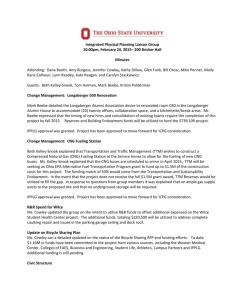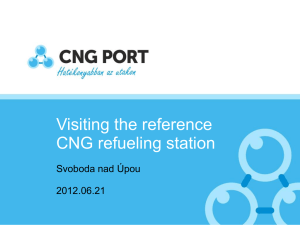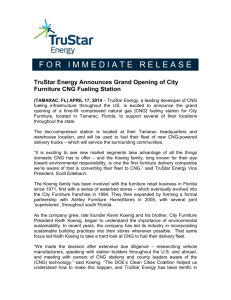File
advertisement
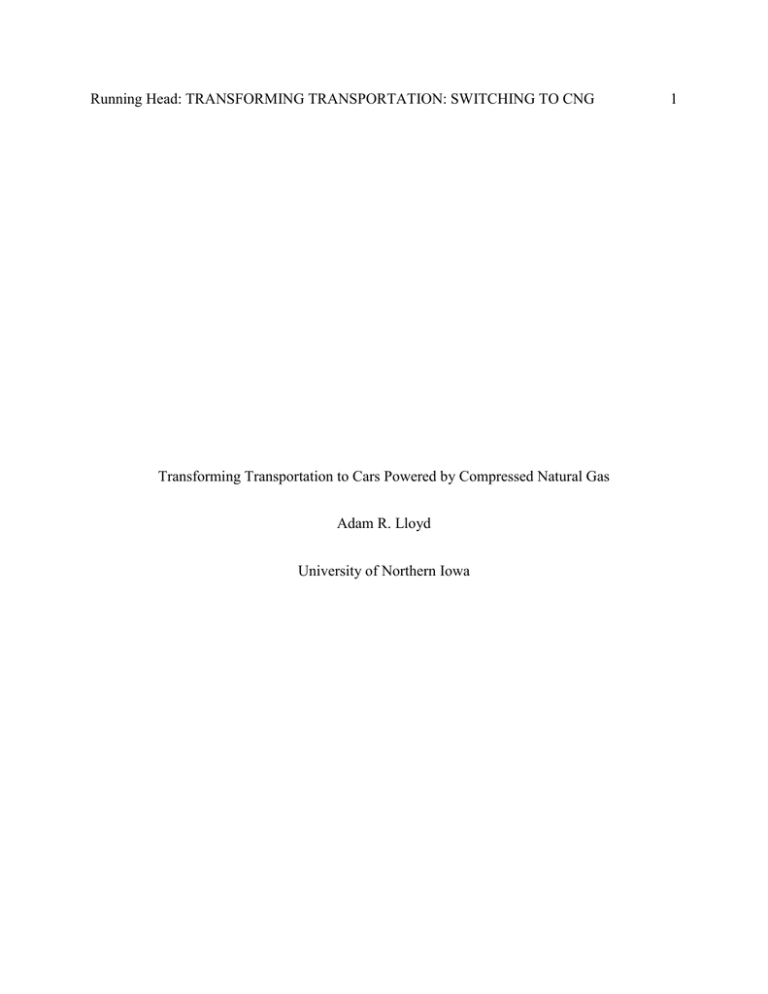
Running Head: TRANSFORMING TRANSPORTATION: SWITCHING TO CNG Transforming Transportation to Cars Powered by Compressed Natural Gas Adam R. Lloyd University of Northern Iowa 1 TRANSFORMING TRANSPORTATION: SWITCHING TO CNG 2 Abstract Throughout this paper, the topic will be the benefits of switching away from petroleum based fossil fuels, such as oil, to a more sustainable energy called compressed natural gas (CNG) in the personal automobile market. This paper will cover not only the benefits of CNG, but will cover how to incorporate this abundant resource as a major part of society. By 2040 my dream is that every household will have at least one that runs on a renewable energy like CNG or electric fuel cells. Also being discussed is the views of those who oppose a switch away from petroleum based fossil fuels and my rebuttal to those ideas. The environmental benefits from switching will be discussed along with why it is important for people to be concerned about this issue and why a switch needs to be made. TRANSFORMING TRANSPORTATION: SWITCHING TO CNG 3 “Compressed natural gas runs at one-third to one-half the current cost of gasoline on an energy-equivalent measure. In a properly tuned engine, natural gas combustion delivers 20 percent lower carbon emissions and about a 25 percent reduction in greenhouse gases compared with the cleanest gasoline engines, all without damaging existing catalytic converter systems (Wojdyla, 2012).” Over the past month I have been researching alternative energies that would be capable of powering personal automobiles in a cleaner and more efficient way than the current petroleum based fossil fuels use. Throughout my research I found that one of the best possibilities for accomplishing the goals of cleaner energy, while maintaining efficiency or increasing it, was Compressed Natural Gas or CNG. I then began specifically researching CNG and the benefits it had, compared to the current systems. The reason I was looking into cleaner energies, was simply to find a way to create cleaner air for generations to come. Although some regulations have been put in place, I believe more attention needs to be drawn to working towards cleaner air, especially in highly populated areas. I want my future grandchildren to be able to play outside as kids and not have to worry about breathing toxic air or worry about harmful UV rays from a hole in our ozone layer. In highly populated areas, converting to a cleaner energy would improve air quality drastically. Look at China during the last summer Olympics, runners were concerned about running in the city because of how poor the air quality was there. A simple switch to a CNG powered car by one person in each household would cause a huge change. I realize that some people may not be able to afford the cost upfront for these conversions to their current car or be able to purchase a new car, but if the government could spend less on TRANSFORMING TRANSPORTATION: SWITCHING TO CNG 4 health care from air quality related illness; they could offer tax refunds or financial help to those who are trying to convert their cars. I will address the topic of health through better air quality and I will discuss ways the government could offer incentives to those for converting their cars or buying new cars powered by CNG. Besides the cost issue, I see no other argument against why we should not work towards a switch to cleaner energies. As a fuel CNG makes up about 24% of the United States Energy consumption, but less than one percent of that is for the use in automobiles (Wojdyla, 2012). Currently, some major car companies produce CNG powered automobiles. Honda currently has a model of their 2012 Honda Civic that is powered by CNG. Its cost is reasonable compared to most new cars coming in at a base price of $26,000, and averages 38 miles per gallon on the highway (Honda: civic natural gas, 2012). There are also shops around the United States where you can purchase a converter system to CNG without ruining your engine or catalytic converter. Although there are regulations in place such as it must be installed by a certified professional. If you have tried to install one yourself it would be a violation of the Clean Air Act’s rules and could run a fine of $5000 per day driving your converted car (Wojdyla, 2012). My hope is that by 2040, every household in the United States of America will have at least one car powered by a form of clean energy. Whether it is CNG, electric fuel cells, or another form of cleaner energy, a change needs to be made in order to keep the environment clean for future generations. Improving air quality will not only improve our environment but will also lighten the burden of health costs related to poor air quality. This change will only cause our domestic economy to grow and will cut our dependency on foreign oil until it is no TRANSFORMING TRANSPORTATION: SWITCHING TO CNG 5 longer needed. To begin, I will discuss how someone would go about converting their current car to run on CNG. In reality, with current laws, this is not necessary information for people to know because you have to be a certified professional in order to convert a car, but in case you are wondering, I will explain. First, you need to update the fuel tank by installing one that is built to contain CNG and has a fuel regulator that is able to reduce the psi from 3600 to 125 so it can be pumped into the engine (Wojdyla, 2012). Next, you need to make sure you have a flex-fuel engine because it has hardened valves and valve seats to contain the CNG. You then need to run a separate fuel line for the CNG to travel through to the engine and connect it to an adaptor that allows both gasoline and CNG to flow through it (Wojdyla, 2012). You may be wondering why there is a need for gasoline to be used; currently, when converting most cars, they have to start with gasoline to heat up the engine (Wojdyla, 2012). Once the engine warms up it then switches over to the CNG and runs on that. However, cars specifically made to run on CNG do not need gasoline to start up. So now you may be saying this is great how much does it all cost? To convert your car to a CNG system it ranges anywhere from $6,500 to $12,000 for a top of the line system (Wojdyla, 2012). Add on another $3500 if you want a home fueling system (Wojdyla, 2012). With a total cost running anywhere from $10,000 to $15,500 you may not be able to afford these changes. Yes it is a large sum of money upfront, however if gas prices continue to stay above $3.00 a gallon it may pay itself off quicker than you think. Currently, the average price per equivalent gallon of CNG only costs $2.13(Austin, 2012). With a national average of $3.65 per gallon, TRANSFORMING TRANSPORTATION: SWITCHING TO CNG 6 (National gas price averages, 2013) you would be saving $1.52 per gallon. That means to fill my car with CNG an equal size tank would save me $26.60 every time I filled up my tank! Sure, it will take some time to make back the upfront money from converting your tank but the money saved after paying off the conversion will quickly add up and be able to pay for other things. Also, the government could give tax refunds to those who did convert their car or buy an energy efficient car because it would improve the environment and lower health costs for things related to poor air quality. Now you may be asking, if this is such a great deal why are more people not taking advantage of this? My answer to that is because of the lack of CNG fuel pumps and places to buy or convert to CNG. Currently, only 36 of the 50 states have a Honda dealership where you can buy a Civic CNG and they are constantly selling out (Austin, 2012). Also due to lack of pumps, there are only 941 high-pressure CNG filling stations in the United States, and most of them are scattered throughout California, Texas, Utah and New York (Wojdyla, 2012). The problem with the current CNG system is that is only has a range of about 200 to 250 miles per tank. With the lack of pumps throughout the United States they would not be ideal for long trips. Also, limited trunk space can cause issues because of the 3600 psi tank that sits behind the rear seats (Austin, 2012). However, this car would be deal for a commute through the city, or to a nearby city, or to work and home because of its cheap fuel and great gas mileage. Some critics who have tested the car have said it lacks power and could be a danger merging onto interstates or highways because of its lack of horse power (Austin, 2012). I agree TRANSFORMING TRANSPORTATION: SWITCHING TO CNG 7 that if this is true, they do need to fix that problem in order to make the car safer and increase demand for the car. Michael Austin of Caranddrivers.com described it like this, “Pick a spot, floor the throttle, wait for the digital speed display to creep up, and hope you judged the traffic gap correctly (Austin, 2012).” To me, this is a danger and not something I would want to have to deal with my first few times driving the car. I feel as though if Honda could improve that feature, there would be no reason to not look at the Civic CNG as a viable option for a new car. So just how bad do current cars being fueled by petroleum based fossil fuels such as oil hurt our environment? Matthew Wald of the New York Times wrote about a study saying, “Burning fossil fuels costs the United States about $120 billion a year in health costs, mostly because of premature deaths from air pollution (Wald, 2009).” He went on to say that the study only took vehicles and power plants into consideration and did not include damages due to global warming which can be caused by the burning of fossil fuels. If switching to environmentally friendly cars could reduce the cost of 120 billion dollars a year spent on air pollution related illness, that money could then be used to help our country even more. The government could use that money for multiple different purposes such as reducing the federal deficit which is at a record high and climbing, to refund those people who are buying ecofriendly cars or converting their current cars to be ecofriendly, or invest in research in development for new technologies that will continue to improve our country. In my opinion these cars powered by CNG would be perfect for big cities. Currently, seven of the top 11 cities with the worst air quality in the United States have a population of over 1,000,000 people (Peeples, n.d.). People who commute to big cities for work usually do not live TRANSFORMING TRANSPORTATION: SWITCHING TO CNG 8 further than 100 miles away; therefore the range of the tank on CNG cars is not a problem that would concern them. On top of that, they would be paying less to run their CNG powered cars because of the cheap cost to purchase it right now. They would also be commuting at times when there would be heavy traffic due to others also trying to get to work and would not be worried about how much horsepower the car has because of slow traffic anyway. If these people were to make a switch to CNG or another green energy type car, they would greatly improve their air quality. There are many economic benefits of switching from petroleum based fossil fuels to CNG. Michael Austin of Caranddriver.com reports, “almost 87% of all CNG sold in the United States is currently produced domestically.” In comparison, only about 39% of oil is produced domestically (Flintoff, 2012). This means that if a major switch occurred, more jobs harvesting CNG would open up in the United States and those companies drilling for oil would be able to switch over to producing CNG, as the market demanded it. Not only would this help our country produce more jobs, it would cut ties with foreign oil companies who may be from unstable regions where an uncertainty causes the price of oil to increase. The United States would become more self-sustainable and would cut our dependency on foreign oil. By cutting our dependency on oil we will be better off domestically and will reap the benefits of cheaper prices to fuel our cars. Right now just over 60% of our oil is imported, the problem with this is that any instability in a region foreign to the United States can cause oil prices to rise. In a USA Today article written by Eamon Javers on what the United States can do to prevent rising gas prices he quoted President Obama saying: TRANSFORMING TRANSPORTATION: SWITCHING TO CNG 9 The amount of oil we drill at home does not set the price of gas by itself. The oil market is global. Oil is brought and sold in a world market. And just like last year, the single biggest thing that is causing the price of oil to spike right now is instability in the Middle East this time around Iran. When uncertainty increases, speculative trading on Wall Street increases and that drives the prices up even more. (Javers, 2012) In regions outside of the United States we have little to no control over stability without a full military presence in the area. Therefore, we have very limited options when it comes to trying to lower prices on oil. Anytime there is fear of losing control, or the possibility of having their product stolen, they increase prices as to make up for any lost product, and because of the risk they take in shipping it. As soon as sellers increase their price, simple economics will show, people tend to cut back by buying less, or find a substitute. When people start buying less oil, this scares the people on Wall Street, as President Obama said, and causes prices to increase even more. This could all be avoided and controlled however, if what was used to power our cars was less expensive and produced domestically. With a switch to CNG, we could not only create new domestic jobs while being able to control and regulate the price of CNG better than we can with oil; but we would also be able to help clean up our air and lower rates of diseases related to poor air quality. It is my hope that by the year 2040, every household has at least one car that is powered by an ecofriendly alternative energy. It will not only improve our environment by doing so, but will also help our economy. CNG offers a much cleaner energy that will greatly reduce air TRANSFORMING TRANSPORTATION: SWITCHING TO CNG 10 pollution and greenhouse gases that the burning of gasoline puts into the air. Cars powered by CNG run at equal or better miles per gallon and are able to obtain speeds just as high as other cars on the market. My hope is that after reading this essay and hearing the claims I made about a switch to CNG, you will consider buying a CNG or ecofriendly powered car. If you have the financial ability, I would also ask you to consider converting your current car to run on CNG. By doing either of these things, you will contribute to a better life for your children and grandchildren by allowing them to play in a cleaner environment. If a change is not made, prices of oil will continue to rise every time instability occurs in the Middle East. Eventually our supply of oil may run out and some studies show that it may happen sooner than we think. Air quality will continue to get worse and worse, especially in big cities. Greenhouse gases will continue to put holes in our ozone layer allowing more harmful ultraviolet rays to hit people who are outside. I personally enjoy the outdoors and would like to allow my grandchildren and great grandchildren to do the same. Without your help in making a change, they may not get that opportunity. Next time you are in the market for a new or a new used car, please consider the impact your purchase will have on the environment. Although you may feel that your contribution means nothing that is simply not true. Every little bit helps because by buying a car that is better for the environment, you may inspire others to do the same. Think about what the implications might be, and make the choice that is not selfish and considers the environment and health for generations to come so they can enjoy the same things our generation has. TRANSFORMING TRANSPORTATION: SWITCHING TO CNG 11 References Austin, M. (2012, March). 2012 Honda civic natural gas. Caranddriver.com. Retrieved from http://www.caranddriver.com/reviews/2012-honda-civic-natural-gas-test-review Cng vehicles. (n.d.). See wide range of vehicles that run on cng. CNGnow.com. Retrieved from http://www.cngnow.com/vehicles/pages/information.aspx Flintoff, C. (2012, April 12). Where does America get oil? you may be surprised. Npr.org. Retrieved from http://www.npr.org/2012/04/11/150444802/where-does-america-get-oil-you-may-be-surprised Honda: Civic Natural Gas. (2012). Honda.com. Retrieved from http://automobiles.honda.com/civicnatural-gas/ Javers, E. (2012, March 2). What can U.S. do to halt rising gas prices? not much. USA Today. Retrieved from http://usatoday30.usatoday.com/money/economy/story/2012-03-03/rising-gas-pricesobama-administration/53323822/1 Lazaroff, C. (2002, September 24). Fossil fuel burning blamed for U.S. parks air pollution. Commondream.org. Retrieved from http://www.commondreams.org/headlines.shtml?/headlines02/0924-08.htm National gas price average. (2013, April 2). AAA.com. Retrieved from http://fuelgaugereport.aaa.com/?redirectto=http://fuelgaugereport.opisnet.com/index.asp Peeples, L. (n.d.). 11 U.S. cities with the worst air pollution. Health Magazine. Retrieved from http://www.health.com/health/gallery/0,,20490855,00.html Ransom, K. (2008, September 26). Natural gas: the next alternative fuel?. CNN.com. Retrieved from http://www.cnn.com/2008/LIVING/wayoflife/09/26/aa.compressed.natural.gas/index.html Wald, M. (2009, October 19). Fossil fuels’ hidden cost is in billions, study says. New York Times. Retrieved from http://www.nytimes.com/2009/10/20/science/earth/20fossil.html?_r=0 Wojdyla, B. (2012, February 10). Should you convert your car to natural gas?. Popular Mechanics. Retrieved from http://www.popularmechanics.com/cars/how-to/maintenance/should-you-convertyour-car-to-natural-gas

